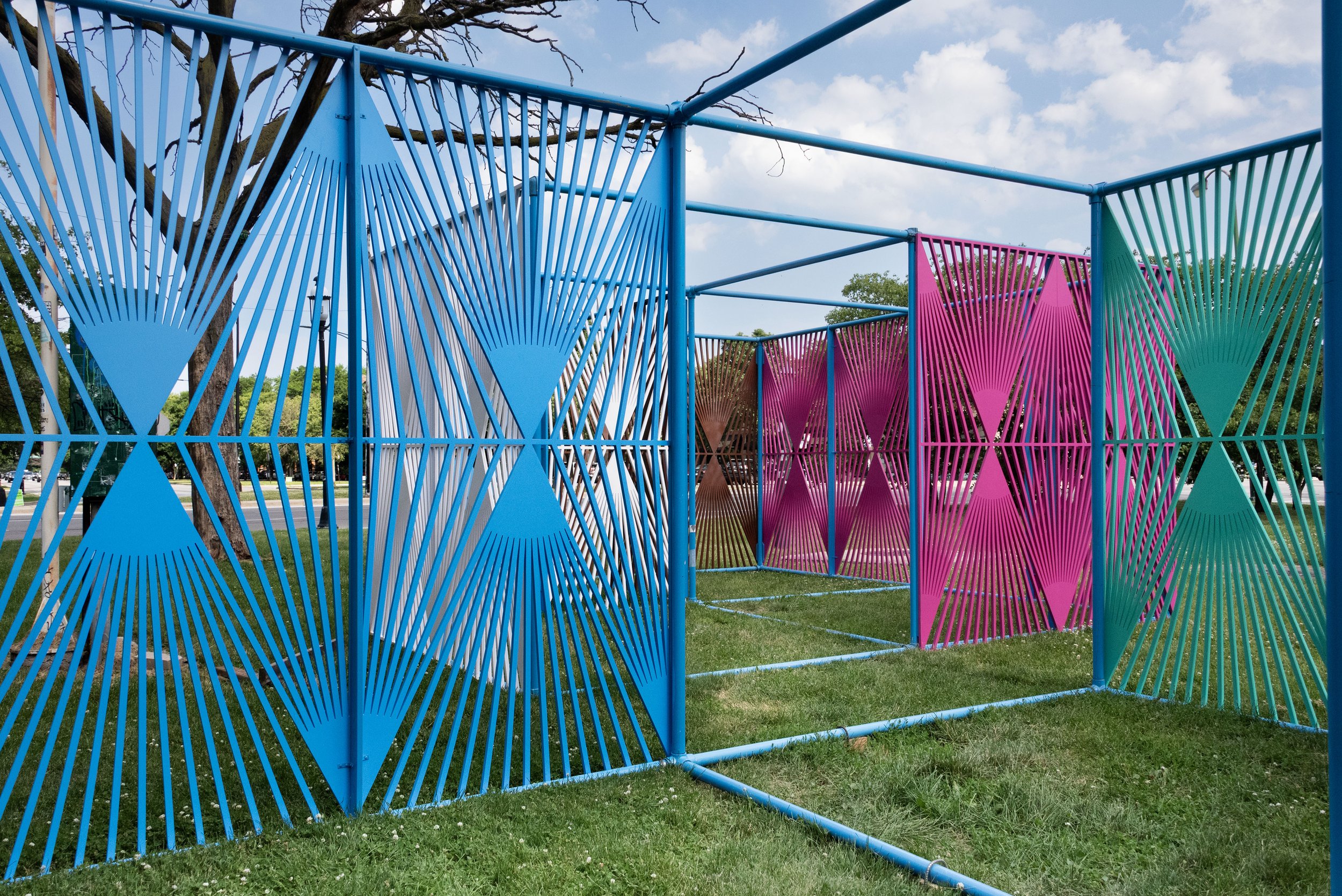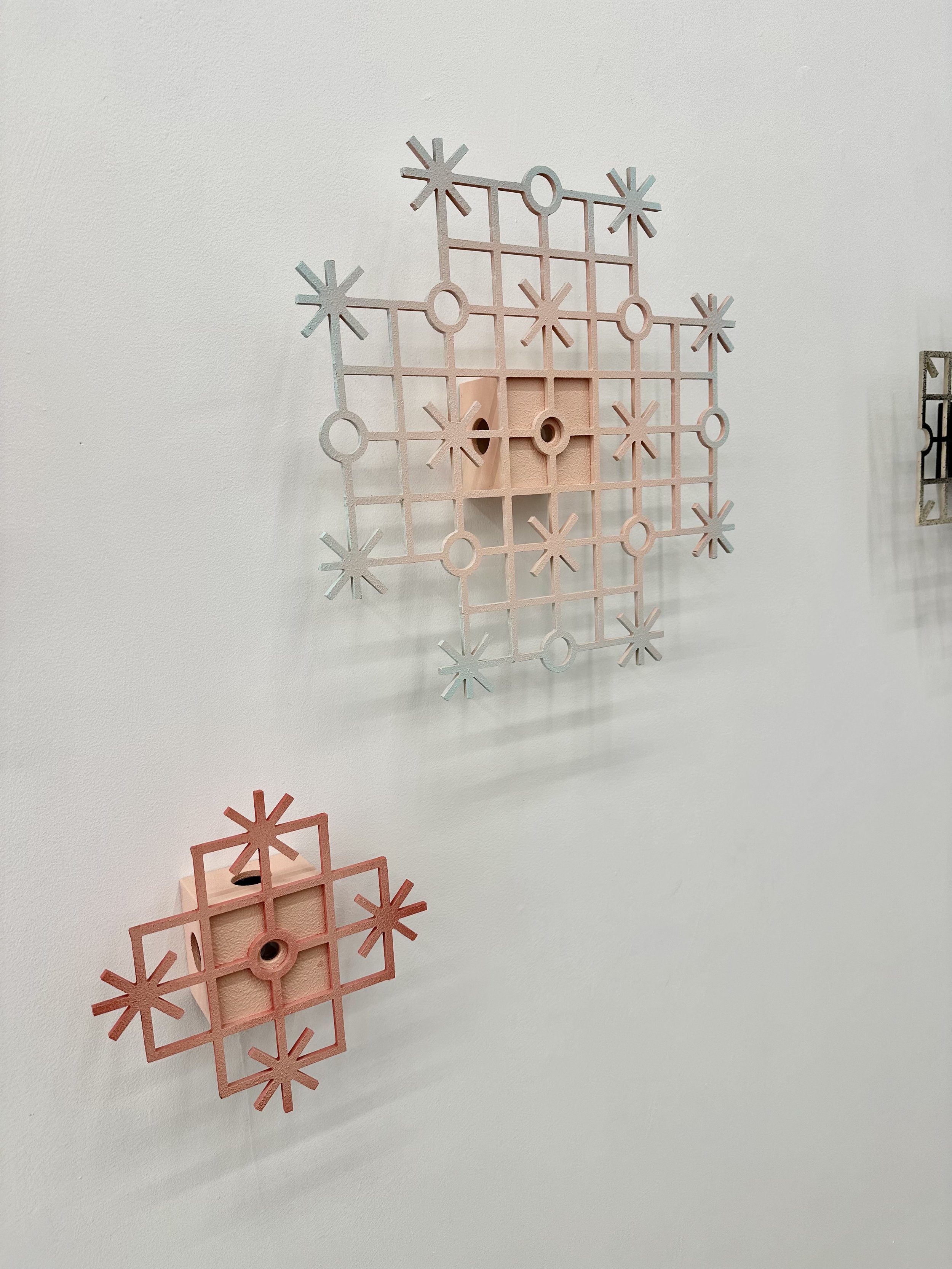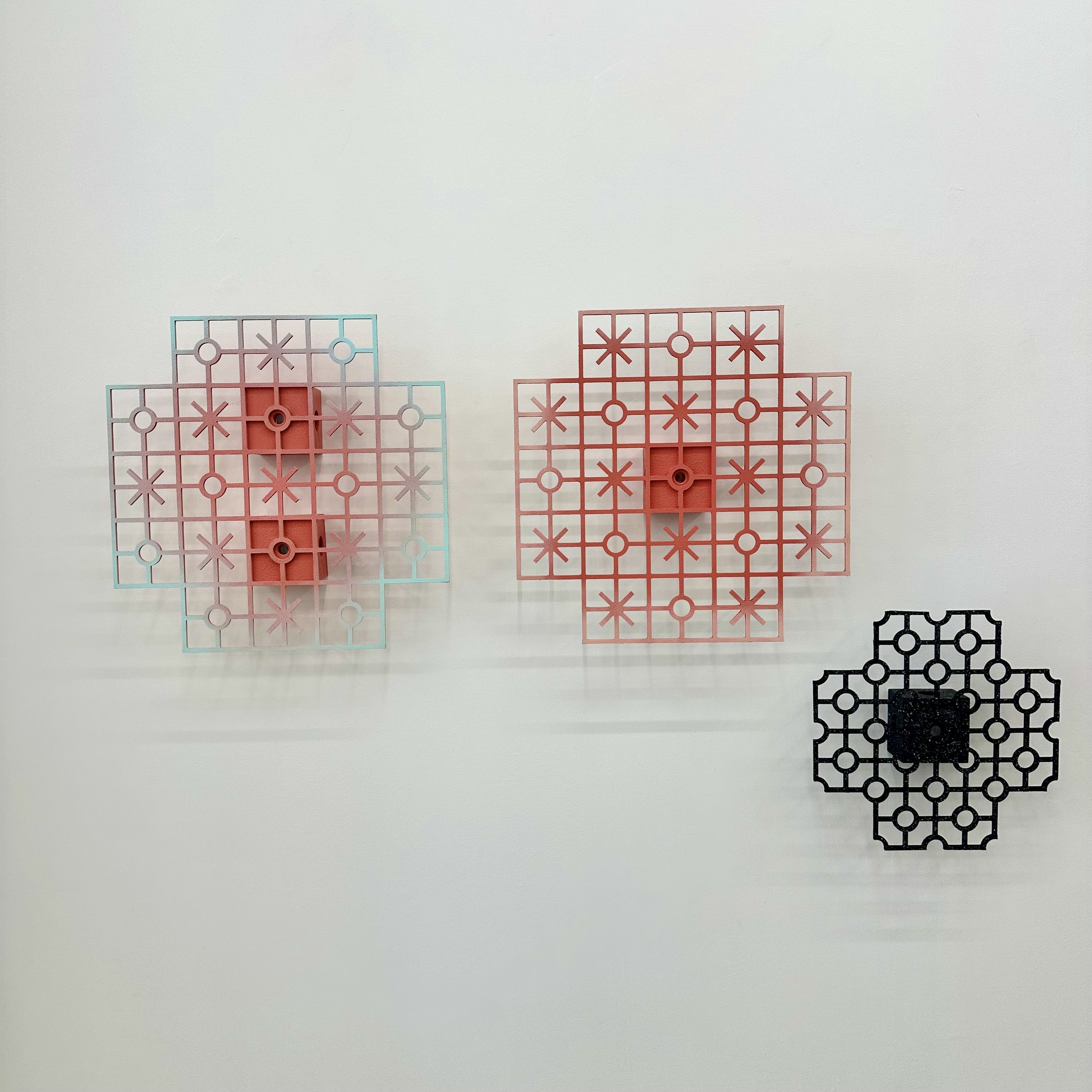Edra Soto's Architectural Intervention
I recently visited Edra Soto’s Public Art Fund installation “Graft” in New York. It lives on a bustling corner of Central Park at the Doris C. Freedman Plaza where 60th Street meets Fifth Avenue overlooking horse carriages, food trucks and the Pulitzer Fountain. The color of a waning Puerto Rican sunset due to its construction in corten steel and terrazzo, “Graft” anchors the area like a welcome gate, bringing an aesthetic gravitas to a spot used to the chaotic comings and goings of tourists, joggers, hawkers, harried professionals, pram-pushing parents and nonchalant pigeons.
But “Graft" is not a gate, nor is it an arch or a doorway, it is an “architectural intervention,” part of a series Soto has developed for over a decade, introducing oft-overlooked, culturally significant details of Puerto Rican vernacular architecture into public American spaces. By featuring graphically repeating designs based on rejas - elaborate iron screens found in working-class Puerto Rican neighborhoods like the one she grew up in – Soto has created a unique vernacular that supports and interrogates her primary themes of immigration, diasporic identity, coloniality, nostalgia and grief.
Allison Glenn, the initial curator of the Public Art Fund Project told me: “When I moved to New York, Edra was the first artist I called. I remember walking along the East River, and thinking intently about the relationships that her work has with the intersecting African and Latin histories and diasporas of the Caribbean, alongside knowing that a Latina artist had not yet been given the chance to develop a public artwork for Central Park. It was the combination of how her work eloquently speaks to the intersecting diasporas from a very intimate and personal place—Puerto Rico—while trusting that her work could reverberate in the same way in New York City.”
The “Graft” series provokes reflection about the colonial condition, hegemonic social constructs, and a longing for home familiar to the Puerto Rican diaspora. In Central Park, “Graft” is also simply beautiful to behold.
“I think my work became a source for understanding how to appreciate what we have. ”
The artist with her Public Art Fund “Graft” in New York.
Edra Soto grew up in Santurce, Puerto Rico and moved to Chicago in her twenties, earning her MFA in 2000 at the School of the Art Institute of Chicago. She is an integral member of the arts community in Chicago where in addition to practicing, curating and teaching she co-directs the outdoor art space The Franklin. Her list of awards and fellowships is long, including the US LatinX Art Forum Fellowship, 2023 and MacArthur International Connections Fund grants in 2020, 2019 and 2018.
Her work is part of the permanent collections of institutions including the Whitney Museum of American Art, Museo de Arte de Puerto Rico and the Museum of Contemporary Art of Chicago.
Since 2013, Soto has created dozens of “Graft” iterations. Her process involves spending ample time at the site to determine how the elements she introduces will relate to the space. “I’ve been calling them interventions because I’m using elements of the residential architecture and trying to understand which elements will work best at the site. It’s a way for me to express a sense of belonging,” she explained when we spoke by Zoom. Each new site becomes a determining factor in the design of the final execution.
“La Casa de Todos (Everyone’s Home)” at Comfort Station, Chicago employed dazzling fuchsia, jade, cerulean and white paint on the conjoined structures and was activated by live programming.
“La Casa de Todos / Everyone’s Home,” reimagines Via Chicago Architect’s + Disenadores’ work SCAFFOLD.
For the Whitney Museum’s 2023 exhibition “There is No Post-Hurricane World: Puerto Rican Art in the Wake of Hurricane Maria,” Soto created a towering blood-red screen of densely repeating Andikra-inspired bent-branch designs which wrapped around a corner wall of the gallery. Tucked into the ironwork, tiny peepholes revealed photographs of Puerto Rican landscapes, rejas and everyday life which in their everyday authenticity countered the media’s relentless images of sensationalized devastation and loss.
Edra Soto, GRAFT, 2022, installation view, the Whitney Museum, New York. Photo James Prinz.
“Casa Isla / Island House” was an arrestingly beautiful execution installed at the Chicago Botanic Garden in 2022, a horizontal cyan shape that appeared to float on water. The artist described the work as “a reflection on states of isolation and the idea of homes as topographical spaces that contain private histories.” She created an illuminated version of “Casa Isla” for the Noor Riyadh Light Arts Festival in the Saudi capital in 2023.
All of these and more can be found on the artist’s website. Additionally, the links section contains writings on Soto’s work by various scholars, curators and artists.
“Casa-Isla | House-Island,” 2022, Chicago Botanic Garden. Photo: Edra Soto.
In her Public Art Fund expression in Central Park, Soto added tables and benches, inviting people to sit and stay a while, like a generous host might do in her own home, or where in Puerto Rico a game of dominos might be played. Dominos, a popular Afro-Carribean pastime and a passion of Soto’s, is a recurring motif.
The Public Art Fund site hosts gatherings and dominos tournaments with The Clemente Soto Velez Cultural and Educational Center. As Public Art Fund’s Senior Curator Melanie Kress explains, "Edra Soto’s artwork “Graft” at Doris C. Freedman Plaza is an invitation to visitors to sit, rest, and dwell inside the artwork. This welcome rest offers an opportunity to contemplate the artwork and its surrounding setting with a small reprieve from the surrounding hustle and bustle. The work’s activation with The Clemente offers further entry points into the work, including as a site for interventional conversations over a game of dominos with important locally-based Latinx cultural practitioners."
“I started questioning the cultural identity of Puerto Rico and how that plays a role in the different aspects of the colonial condition. How that becomes a subtle but important aspect of how you don’t have a broad view of who you really are. There is an identity that is affiliated with the colonial architecture that prevails in Puerto Rico – Spanish Colonial architecture. The motifs that I represent in my work come from residential architecture, working class homes of Puerto Rico.”
“Graft” is by design both open and solid. Through it you can see people moving as if they are on the inside of a house, reminiscent of Soto’s experience growing up with rejas on her own home’s exterior facade. Walk around and look at “Graft” from as many angles as you choose. Its lines constantly change, both guard rail and invitation. You are both inside and out, invited in and kept outside. Much of Soto’s oeuvre explores this specific tension between the inner world and the outer, the personal and the public self, the individual and the cultural. What does it mean to be a Puerto Rican living in the United States? A tax payer subject to the same laws but unable to vote in, for example, the upcoming Presidential election? As Kress explained, “For Soto, feelings of dislocation are compounded by the island’s ambiguous status as an unincorporated territory of the United States.”
Soto told me, “It took a lot of meditation to get to the point of what that work looks like — aesthetically, its dimensions, the properties for engagement, how people can navigate it and its relationship to the park. This is about celebrating the working class communities of Puerto Rico. This architecture is emblematic of those communities. One thing that made me excited about Central Park was the history of displacement and that it is in a very affluent area, so it automatically provides a big contrast.”
“Graft (Bus Shelter) created for the Chicago Architecture Biennial, modeled on Puerto Rico's idiomatic bus shelters and installed permanently.
As is probably apparent by this point, Edra Soto brings a deep academic rigor to her practice. Her research on Puerto Rican architectural history led her to the writings of Professor Jorge Ortiz Colom, including his monograph, “The African Influence in the Design-Build Edification of Puerto Rico.” Colom revealed that “criollo architecture, which incorporates broken soles (soles truncos – semicircular features installed above doorways to admit airflow) and rejas, originated from sub-Saharan Africa through the population brought to Puerto Rico as slaves to work plantations during the rise of colonization.” As Soto explained to me, this has been largely ignored by historians who assumed it would have been impossible for African slaves to express their ancestral traditions in the inhumane and repressive conditions under which they lived. Therefore the decorative architecture was assumed to be a tropicalized interpretation of European styles, robbing it of it’s true origins, a fallacy Soto’s work aims to correct.
“Sol Centro I,” 2023. Courtesy of the artist. Part of the solo exhibition “lazos terrenales / earthly bonds” at the Institute of Contemporary Art at Maine College of Art and Design, July - September 2024.
The artist with “El Destino / Destination” part of a group exhibition “Widening the Lens: Photography, Ecology, and the Contemporary Landscape,” Carnegie Museum of Art.
Soto introduces African design elements by adopting Adinkra symbology, visual representations of proverbs used by the Akan of Ghana. Pulled from Soto’s personal archive of Puerto Rican decorative concrete blocks called quiebrasoles, the designs pay homage to the African origins of Puerto Rican vernacular motifs. “Adinkra are symbols from Ghana that represent concepts or aphorisms and are used extensively in fabrics, logos, pottery and architecture. In Adinkra, the 4 point star or Eban, is a symbol of love, safety and protection.” (Edra Soto).
Love, safety and protection were top of mind in a solo show at Morgan Lehman Gallery ,“por la señal | By a Signal” which ran through October 5. Recently the artist suffered the devastating loss of her mother, with whom she was extremely close. Soto’s experience of going back and forth between Chicago and Puerto Rico to care for her accentuated feelings of being here and there, or neither here nor there, something she explores in a group of small wall pieces made in the shape of a cross. These “picture frames” as the artist calls them, draw viewers in through the exterior of the decorative screens, painted with a rough spray paint effect in muted domestic colors like peach, beige and teal. Soto is a self-described obsessive photographer, maintaining a huge archive of personal photographs of family and home. For “Por la Señal” she installed viewfinders in the center of the crosses, compelling visitors to look inside of her life, her heart, her home, at images of her mother and her life in Puerto Rico.
Installation view from “por la señal” at Morgan Lehman Gallery, New York. Photo: Robin Hauck.
“The crosses are about direction… The title of the exhibition is “por la signal,” the name of the Catholic prayer one makes when making the sign of the cross… My mother’s ability to speak was gone, and I started thinking about the sign of the cross — the signal, as a form of communication. Trying to make sense of something you cannot make sense of,” Soto said, reflecting on her difficult creative process following the heartbreaking loss.
Gallerist Sally Morgan explained, “The sculptures we showed recently, por la senal, invite close looking, and the viewfinders all include her own personal images of Puerto Rico: her childhood home, her family, the landscape and architecture of the island. They are very intimate, both in scale and in the mode by which they are experienced. I feel like this is typical of Edra's work from the beginning, and no matter the scale, there are moments that invite the viewer to have a deeply personal interaction with the work.”
As Soto told me, “these are as close to me as you are going to get.”
“A lot of my work deals with grief. Not only the loss of my parents, but the loss of the land and my life in Puerto Rico. I’m really trying to express the condition of someone who migrated through my work.”
Installation view from “por la señal” at Morgan Lehman Gallery, New York. Photo: Robin Hauck.
Installation view from “por la señal” at Morgan Lehman Gallery, New York. Photo: Robin Hauck.
“Graft” means transplant. Soto, in her own way a transplant from Puerto Rico to Chicago, grafts her knowledge of her country’s rich, complex history onto our dense American soil, encouraging it to take root. The open work of her fractal geometric designs encourages flow back and forth — like the airflow encouraged by the original rejas.
By sharing her personal archives in her wall pieces and erecting architectural interventions in busy public spaces, Soto facilitates communal experience and cultural absorption – wonder at the beauty of her physical designs, awe at her emotional courage, appreciation for the new perspective on a familiar place. This is Soto’s way of democratizing her art, it is for everyone and everyone becomes part of realizing its power. Whether or not every passerby in Central Park fully comprehends the Puerto Rican culture being grafted onto visitors to Central Park, the installation lives as a bold participant in a contemporary conversation about identity, statehood, history, tradition and belonging.
“Graft” will be on view in Central Park through August 24, 2025.
Edra Soto Upcoming Exhibitions:
A Tale of Today: Materialities, Driehaus Museum, February 5, 2025 / February 7, 2025, through April 27, 2025
The Outwin 2025: American Portraiture Today (traveling exhibition) on view at the National Portrait Gallery: May 3, 2025 – February 2026
El Vaivén: 21st Century Art of Puerto Rico and Its Diaspora, Katherine E. Nash Gallery, University of Minnesota, Minneapolis September 9 – December 6, 2025
Diasporic Collage: Puerto Rico and The Survival of a People (traveling exhibition), Eli and Edythe Broad Art Museum, August 31, 2024 - February 2, 2025























